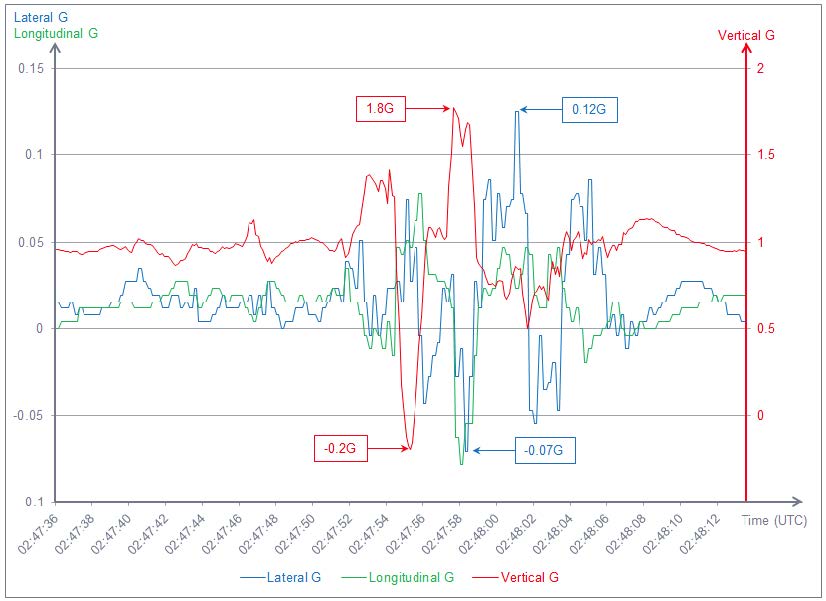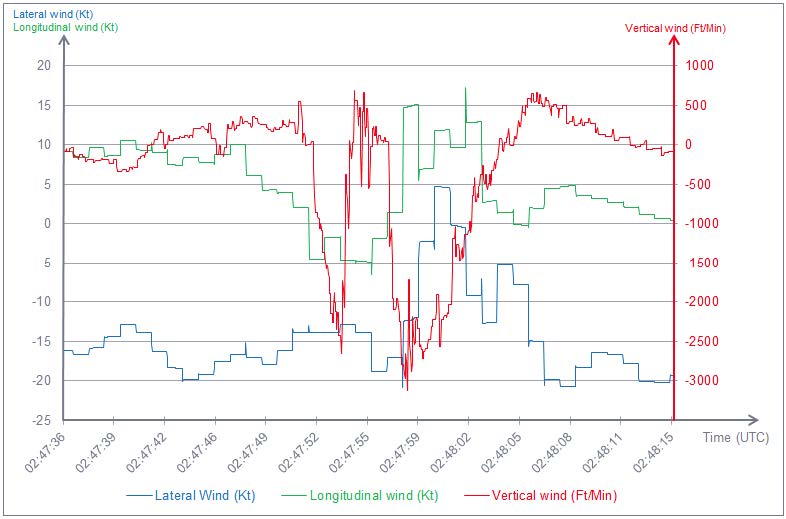What happened
On 28 November 2016, at about 1656 Coordinated Universal Time (UTC),[1] a China Eastern Airlines Airbus A330-243, registered B-5821, operating flight MU-777, departed Kunming, China, for Sydney, New South Wales. On board were 14 crew and 213 passengers.
As the aircraft approached Sydney, the flight crew commenced descent from flight level (FL) 370.[2] The flight crew advised the cabin crew of the descent and illuminated the seatbelt signs. The cabin crew manager announced to the passengers that the aircraft was on descent to Sydney and that as the seatbelt sign had been illuminated they needed to fasten their seatbelts. The cabin crew proceeded to check that passengers had their seatbelts fastened, starting from the front rows and moving towards the back of the cabin.
During descent, the flight crew diverted 5 NM from the flight route due to thunderstorms. Once clear of weather, they received instructions to descend via waypoint[3] BOREE.
At 0248 UTC at FL 230, about ten minutes after the seatbelt sign had been illuminated, the aircraft experienced a severe turbulence event which lasted about 30 seconds. The flight crew commenced the turbulence checklist as per the quick reference handbook (QRH), starting with ‘ignition on’, but as the turbulence had stopped, the rest of checklist was not completed. They checked the flight instruments and engine indications, which were normal, so the flight was continued to Sydney.
Prior to the event, the cabin crew manager was at the back of the cabin checking seatbelts and observed four passengers without a seatbelt, one of whom was standing and reaching for their baggage. During the turbulence event, the cabin crew manager struck their back on a seat armrest. A cabin crewmember in front of the cabin crew manager fell to the ground. Two of the passengers without seatbelts struck their head on the ceiling. After the event, all cabin crewmembers returned to their seats.
After landing, at around 0314 UTC, a cabin crewmember informed the flight crew that there were eleven people who were injured, including three cabin crew. The aircraft sustained minor damage to the interior cabin above row 42, 64, 65, and 68 (Figure 1).
Figure 1: Damage to cabin (row 42, and 68 passenger service unit)

Source: Operator (annotated by the ATSB)
Captain’s comments
The captain provided the following comments:
- On approach to Sydney, the crew did not receive any reports regarding turbulence. They did observe other aircraft divert to avoid the thunderstorms.
- Once they completed the diversion around the thunderstorms, there was no further weather on the radar.
- During the descent, there was some cloud scattered, but no dangerous weather, because they had diverted from the thunderstorms 5–8 minutes earlier.
- The turbulence they experienced was different to any turbulence they experienced before, as it was very short, but very strong.
- As the turbulence event was very short, they did not report it to ATC.
- During the turbulence, there was little change in airspeed or rate of descent.
- The flight crew did not realise that there were any issues within the cabin until after landing. Normally, they would be notified by the cabin crew if there were injuries.
- The flight crew did not make any announcement to passengers, nor cabin crew about the turbulence, as they did not have any warning.
Cabin crew manager comments
The cabin crew manager provided the following comments:
The seatbelt sign had been switched on about 10 minutes before the turbulence.
The cabin crew were preparing the aircraft for landing, and ensuring that passengers had their seatbelts on, when the turbulence event occurred.
The cabin crew did not notify the captain until after landing as the cabin crew manager was injured and they were aware the flight crew were preparing for landing.
The cabin crew had to keep encouraging passengers to fasten their seatbelts during the flight.
Flight data
The aircraft manufacturer provided the ATSB with a report of the data extracted from the digital flight data recorder (DFDR). The data shows that when the aircraft encountered the turbulence, the vertical G[4] loadings varied between -0.20 G and 1.8 G and the lateral G loadings varied between -0.07 G and 0.12 G (Figure 2). The calculated longitudinal wind varied between around 15 kt tailwind and 5 kt headwind and the lateral wind varied between 20 kt right and 5 kt left. The vertical wind reached a maximum of about 3,100 feet per minute updraft (Figure 3). During the turbulence, the autopilot stayed engaged and the load factors experienced during the turbulence did not exceed the limits of the aircraft.
The rapid changes to wind speed and direction confirm the aircraft encountered turbulence conditions.
Figure 2: G Loadings during turbulence

Source: Airbus
Figure 3: Wind variation during turbulence

Source: Airbus
Bureau of Meteorology report
The Bureau of Meteorology (BoM) provided the ATSB with a report detailing the weather at the time of the incident, including conditions, the weather forecast, warnings, and satellite and radar imagery.
The report showed that there were light winds between 20 to 30 kt from FL180 to FL450. There was no significant weather at the time of the turbulence.
It is likely that the turbulence encountered was the result of developing thunderstorms in the area.
Clear air turbulence
Clear air turbulence (CAT) is defined as sudden severe turbulence occurring in cloudless regions that causes violent buffeting of aircraft.
CAT can be serious, because it is not shown on weather radar, meaning it is difficult for pilots, air traffic controllers, and weather forecasters to detect. It can also occur when no clouds are visible. It is common at high altitudes, especially in the vicinity of jetstreams.
Previous occurrences
A search of the ATSB database found the following occurrences where aircraft encountered clear air turbulence resulting in injuries on board:
- On 27 October 2000, a Boeing 747 encountered clear air turbulence en route from Sydney to Osaka, Japan (ATSB investigation 200005031). Although the weather forecast indicated thunderstorms within 110 NM of the flight route there was no turbulence forecast. When the CAT stuck, the seatbelt sign was not illuminated, and people were moving about the cabin. Two passengers sustained broken ankles.
- On 10 May 2013, a Bombardier DHC-8 encountered clear air turbulence about 49 NM north of Townsville, Queensland (ATSB investigation AO-2013-084). The turbulence lasted about 10 seconds. The crew did not observe any cloud and the weather radar did not show any significant weather for the entire flight. Two cabin crew members who were standing at the time sustained head injuries, one of whom was knocked unconscious. Two flight crew sustained minor injuries when objects were thrown around the flight deck.
Safety analysis
The aircraft encountered unforecast CAT about ten minutes after the seatbelt sign had been illuminated for the descent into Sydney. The cabin crew were preparing the cabin for landing. A number of passengers and members of the cabin crew, towards the back of the aircraft, who were not wearing seatbelts, were injured during the CAT event. They sustained head, neck, hand, back, and abdominal injuries.
Finding
This finding should not be read as apportioning blame or liability to any particular organisation or individual.
- The aircraft encountered CAT. The cabin crew and passengers who were injured during the turbulence did not have seatbelts fastened, despite the seatbelt sign being switched on.
Safety message
A clear air turbulence encounter can be a surprising experience for both crew and passengers. A safety bulletin published by the ATSB Staying safe against in-flight turbulence, noted that almost all turbulence injuries involved people who are not properly seated and do not have their seatbelt fastened. This incident is a timely reminder of the importance of having the seatbelt fasted when the seatbelt sign is switched on and to pay attention to instructions given by the cabin crew, so that injuries during a turbulence encounter can be minimised.
Aviation Short Investigations Bulletin - Issue 58
Purpose of safety investigationsThe objective of a safety investigation is to enhance transport safety. This is done through:
It is not a function of the ATSB to apportion blame or provide a means for determining liability. At the same time, an investigation report must include factual material of sufficient weight to support the analysis and findings. At all times the ATSB endeavours to balance the use of material that could imply adverse comment with the need to properly explain what happened, and why, in a fair and unbiased manner. The ATSB does not investigate for the purpose of taking administrative, regulatory or criminal action. TerminologyAn explanation of terminology used in ATSB investigation reports is available here. This includes terms such as occurrence, contributing factor, other factor that increased risk, and safety issue. Publishing informationReleased in accordance with section 25 of the Transport Safety Investigation Act 2003 Published by: Australian Transport Safety Bureau © Commonwealth of Australia 2017
Ownership of intellectual property rights in this publication Unless otherwise noted, copyright (and any other intellectual property rights, if any) in this report publication is owned by the Commonwealth of Australia. Creative Commons licence With the exception of the Coat of Arms, ATSB logo, and photos and graphics in which a third party holds copyright, this publication is licensed under a Creative Commons Attribution 3.0 Australia licence. Creative Commons Attribution 3.0 Australia Licence is a standard form licence agreement that allows you to copy, distribute, transmit and adapt this publication provided that you attribute the work. The ATSB’s preference is that you attribute this publication (and any material sourced from it) using the following wording: Source: Australian Transport Safety Bureau Copyright in material obtained from other agencies, private individuals or organisations, belongs to those agencies, individuals or organisations. Where you wish to use their material, you will need to contact them directly. |
__________
- Coordinated Universal Time (abbreviated UTC) is the time zone used for civil aviation. Local time zones around the world can be expressed as positive or negative offsets from UTC.
- At altitudes above 10,000 ft, an aircraft’s height above mean sea level is referred to as a flight level (FL). FL370 equates to 37,000 ft.
- A pre-determined geographic position in airspace.
- G load: the nominal value for acceleration. In flight, g load represent the combined effects of flight manoeuvring loads and turbulence and can have a positive or negative value.


